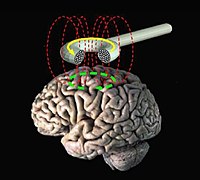
Photo from wikipedia
ABSTRACT Objectives: We investigated the neural mechanism of transcranial direct current stimulation (tDCS) in the treatment of post-stroke depression (PSD) using functional near-infrared spectroscopy (fNIRS). Methods: Twenty-six patients with PSD… Click to show full abstract
ABSTRACT Objectives: We investigated the neural mechanism of transcranial direct current stimulation (tDCS) in the treatment of post-stroke depression (PSD) using functional near-infrared spectroscopy (fNIRS). Methods: Twenty-six patients with PSD were randomly divided into an experimental group receiving tDCS and a control group receiving sham stimulation. The anode and cathode were placed on the left and right dorsolateral prefrontal cortex (PFC). Patients underwent fNIRS before and after treatment, combined with an emotional face sex judgment task and a ‘1-back’ working memory task to assess reaction times and relative concentration changes of oxyhemoglobin (Oxy-Hb) in the PFC. Results: Reaction times for faces showing positive emotions decreased after treatment in the experimental group (P < 0.05). For faces showing negative emotions, relative Oxy-Hb concentration changes in the PFC were higher after treatment (P < 0.05), but there was no significant difference between the experimental and the control group. Reaction times during the working memory task in the experimental group were shorter after treatment (P < 0.05), and there was a significant difference between the groups (P < 0.05). Relative Oxy-Hb concentration changes in the left PFC were significantly higher after treatment in the experimental group (P < 0.05), and concentration changes in the right PFC after treatment were significantly higher in the experimental than in the control group (P < 0.05). Discussion: tDCS may improve the processing of negative emotions and working memory in patients with PSD by enhancing aerobic metabolism in the PFC, thereby improving depressive symptoms.
Journal Title: Neurological Research
Year Published: 2019
Link to full text (if available)
Share on Social Media: Sign Up to like & get
recommendations!